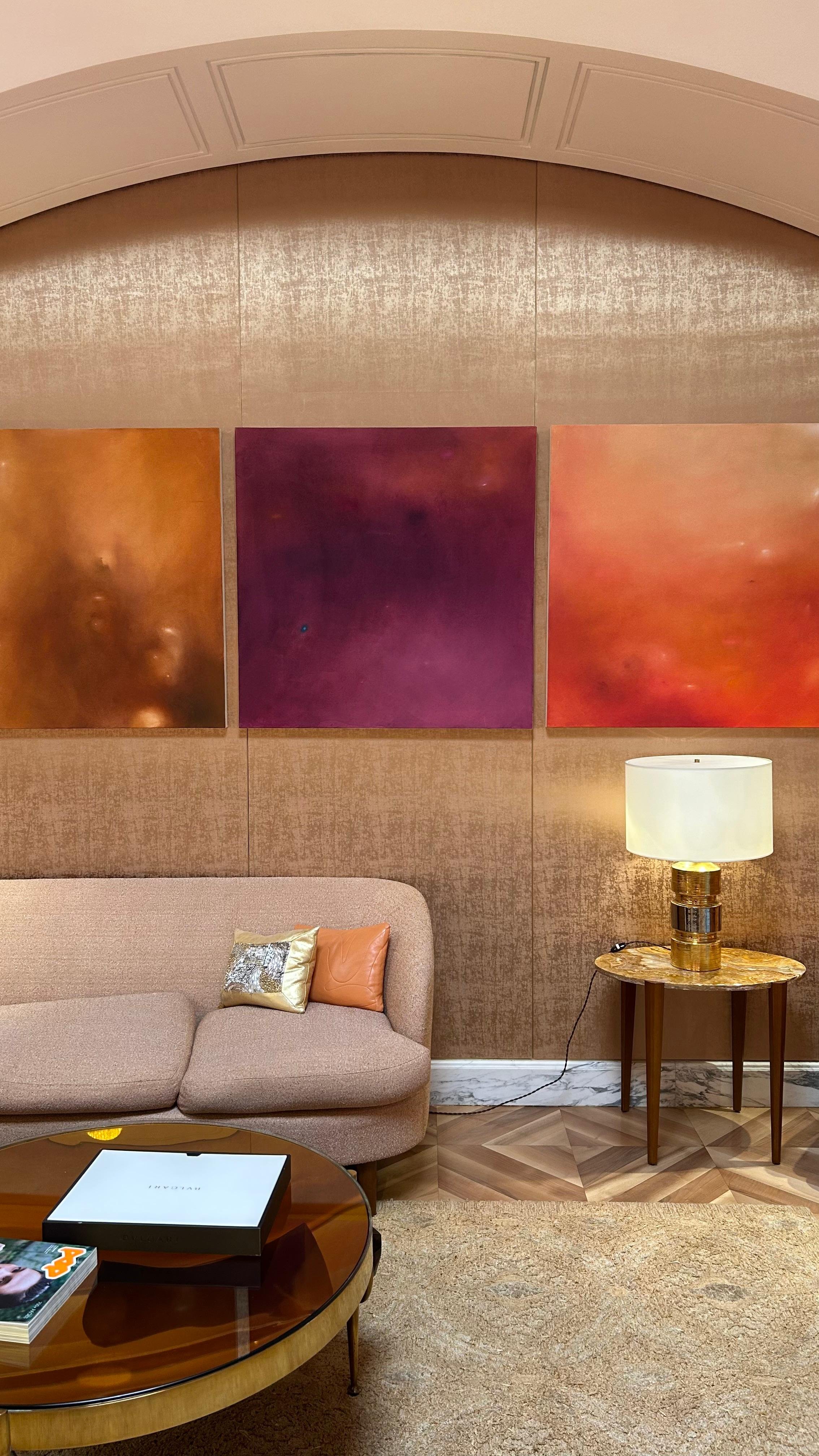From Collage to Canvas: Alexander James and the Art of Layers
Alexander James doesn’t just work with colour and form—he assembles, sculpts, distorts, and plays. His canvases speak in fragments and collisions, echoing a practice that began with scissors, cameras, and rolls of film, not brushes. From collaging as a teenager to painting on towering, immersive canvases, he has always been led by intuition, process, and an urge to break apart and rebuild.
“When I was younger, I used to photograph a lot on film, develop it, cut things out… I was always into collaging—just putting things from different places together… it all started with photography and film.”
Alexander James: Cutting and Pasting and Painting
A graduate of the Camberwell School of Arts, the seeds of Alexander’s painting practice were sown in darkrooms and scrapbooks. Early influences like Robert Rauschenberg pointed him toward the fertile, messy intersections of media. “He was one of the first artists I discovered. I just fell in love with the idea of putting things from different places together.”
Soon, collage turned into painting—but never fully left it. His canvases carry that same layered texture. Even his brushwork feels crafted and layered. He paints not only as a painter, but like someone still cutting and pasting, still thinking in pieces and joins, fragments, sections and layers. “The way I approach painting is very much by sculpture… I kind of want these paintings to feel physical.”
The Flow
Though he begins with certain colours or loose compositions in mind, nothing is rigid. “So much changes the whole time,” he says. “Very rarely does it end where it started.” For him, painting is less about execution and more about discovery. “It’s a process. Everyone has their own, but when you’re in the act of painting, you’re in this kind of outer world.” Flow state. “Yes, apparently you get it when you meditate—or play sports.”
This kind of flow state requires focus—and, often, mood. Alexander doesn’t force the work when he’s off-centre. If he’s in a bad headspace, he’ll sketch, reflect, or rearrange instead. “I can be in a bit of a bad mood and paint. But if I’m really not feeling it at all, then I’ll sketch or do some other stuff.”
“It’s like a song and a dance,” he says, describing how he moves around his large-scale canvases. He’s drawn to bigger formats for exactly that reason: the way they let the body stretch, gesture, sweep. “I like larger. It facilitates the type of painting I’m making. You’re working with full-body extensions and ranges of movement.” And yet, he also enjoys the intimacy of the miniature. Tiny works allow for different types of play. He often makes both, expansive and compact, and finds their contrast productive. “Smaller work can be playful. I love it. There’s no right or wrong answer.”
Colour Moods
Like many painters, Alexander’s studio soundscape shapes his work. He paints to albums rather than playlists—letting the music flow without interruption .“I go for albums, because I don’t need to change the track every second. That’s an important thing—otherwise it’s distracting.” But his musical moods shift just like his colour palettes. At the moment, he’s playing with brighter, saturated tones. “I've been thinking a lot about warm tones recently. But I go through moments. Sometimes it’s marine blue. Sometimes it’s brown. I’ll exhaust a palette before I move on.”
The Legacy of Film
Film was his first love, and its echoes are everywhere in his work. He used to pause VHS tapes and capture the distortions—warped mouths, floating eyes, visual misalignments. These moments helped him break from conventional figuration. “I used to use VHS cameras, pause them at certain moments. It made me realise faces don’t have to stay in one place. That became something I explore through paint. It got me thinking about how features don’t need to be where we expect them. An eye can be somewhere else. A mouth at a different angle. That all came from film.”
Left: Sunrise Right: Wide-eyed, 2023
His fascination with moving image, texture, and visual displacement feeds directly into his paintings. Faces appear, then recede. Bodies collapse and reform. His canvases almost seem to glitch like a paused analog tape. The mix of human form and abstraction is something of his signature. “My mum found this box of old stuff I did. There were these weird shapes I’d created and made up, and faces within them. It was abstract, but kind of funny. That’s always been there, it’s intentional.”
Memory, Material, and Movement
Alexander’s sources of inspiration are diverse: family stories, sculpture from antiquity, internet archives, personal memory and more. His practice is as much about absorbing visual languages as inventing them. “I look at a lot of limestone sculptures from 500 BC. I think those original paintings in stone are really beautiful. I used to have them all over my studio—historical stuff, family events, old photography.” This archival approach is more poetic than encyclopedic. It’s about atmosphere, lineage, texture.
Alexander James, Looking Forward
What unites all of this—collage, brushstroke, glitch, movement—is his deep curiosity about how things fit together (or don’t). His work is elastic, open, and dynamic. He doesn’t make in bulk; he makes with care, with attention, and only when it feels necessary. “I don’t make that much in a year, actually”. There’s a self-awareness to him that feels both grounded and exploratory. He isn’t trying to define a legacy. He’s just trying to keep discovering. “I can’t answer for the future. But I can answer for now, I still have a lot to explore.”







